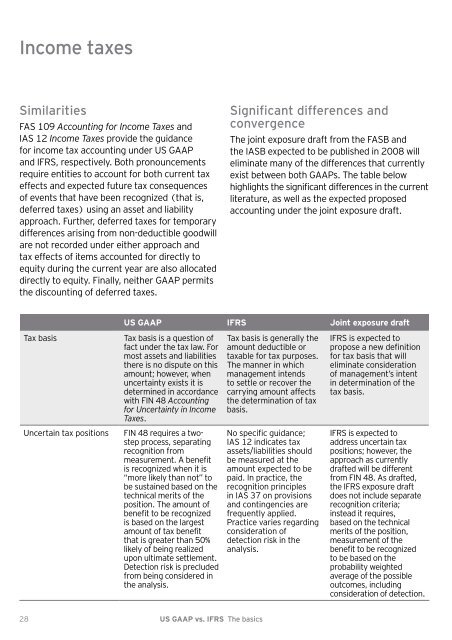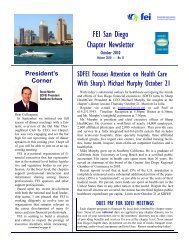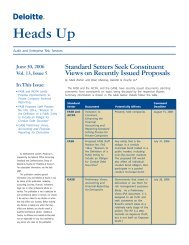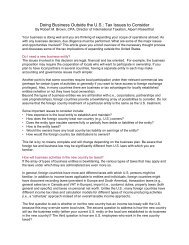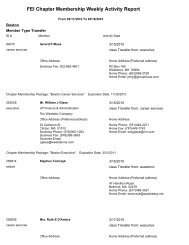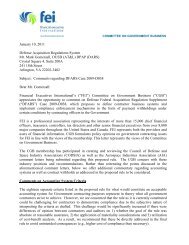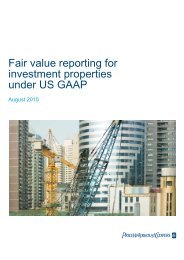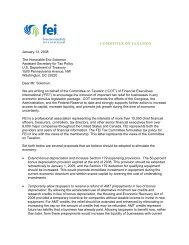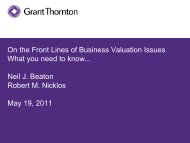US GAAP vs. IFRS The basics - Financial Executives International
US GAAP vs. IFRS The basics - Financial Executives International
US GAAP vs. IFRS The basics - Financial Executives International
Create successful ePaper yourself
Turn your PDF publications into a flip-book with our unique Google optimized e-Paper software.
Income taxes<br />
Similarities<br />
FAS 109 Accounting for Income Taxes and<br />
IAS 12 Income Taxes provide the guidance<br />
for income tax accounting under <strong>US</strong> <strong>GAAP</strong><br />
and <strong>IFRS</strong>, respectively. Both pronouncements<br />
require entities to account for both current tax<br />
effects and expected future tax consequences<br />
of events that have been recognized (that is,<br />
deferred taxes) using an asset and liability<br />
approach. Further, deferred taxes for temporary<br />
differences arising from non-deductible goodwill<br />
are not recorded under either approach and<br />
tax effects of items accounted for directly to<br />
equity during the current year are also allocated<br />
directly to equity. Finally, neither <strong>GAAP</strong> permits<br />
the discounting of deferred taxes.<br />
Tax basis Tax basis is a question of<br />
fact under the tax law. For<br />
most assets and liabilities<br />
there is no dispute on this<br />
amount; however, when<br />
uncertainty exists it is<br />
determined in accordance<br />
with FIN 8 Accounting<br />
for Uncertainty in Income<br />
Taxes.<br />
Uncertain tax positions FIN 8 requires a twostep<br />
process, separating<br />
recognition from<br />
measurement. A benefit<br />
is recognized when it is<br />
“more likely than not” to<br />
be sustained based on the<br />
technical merits of the<br />
position. <strong>The</strong> amount of<br />
benefit to be recognized<br />
is based on the largest<br />
amount of tax benefit<br />
that is greater than 50%<br />
likely of being realized<br />
upon ultimate settlement.<br />
Detection risk is precluded<br />
from being considered in<br />
the analysis.<br />
28 <strong>US</strong> <strong>GAAP</strong> <strong>vs</strong>. <strong>IFRS</strong> <strong>The</strong> <strong>basics</strong><br />
Significant differences and<br />
convergence<br />
<strong>The</strong> joint exposure draft from the FASB and<br />
the IASB expected to be published in 2008 will<br />
eliminate many of the differences that currently<br />
exist between both <strong>GAAP</strong>s. <strong>The</strong> table below<br />
highlights the significant differences in the current<br />
literature, as well as the expected proposed<br />
accounting under the joint exposure draft.<br />
<strong>US</strong> <strong>GAAP</strong> <strong>IFRS</strong> Joint exposure draft<br />
Tax basis is generally the<br />
amount deductible or<br />
taxable for tax purposes.<br />
<strong>The</strong> manner in which<br />
management intends<br />
to settle or recover the<br />
carrying amount affects<br />
the determination of tax<br />
basis.<br />
No specific guidance;<br />
IAS 12 indicates tax<br />
assets/liabilities should<br />
be measured at the<br />
amount expected to be<br />
paid. In practice, the<br />
recognition principles<br />
in IAS 37 on provisions<br />
and contingencies are<br />
frequently applied.<br />
Practice varies regarding<br />
consideration of<br />
detection risk in the<br />
analysis.<br />
<strong>IFRS</strong> is expected to<br />
propose a new definition<br />
for tax basis that will<br />
eliminate consideration<br />
of management’s intent<br />
in determination of the<br />
tax basis.<br />
<strong>IFRS</strong> is expected to<br />
address uncertain tax<br />
positions; however, the<br />
approach as currently<br />
drafted will be different<br />
from FIN 8. As drafted,<br />
the <strong>IFRS</strong> exposure draft<br />
does not include separate<br />
recognition criteria;<br />
instead it requires,<br />
based on the technical<br />
merits of the position,<br />
measurement of the<br />
benefit to be recognized<br />
to be based on the<br />
probability weighted<br />
average of the possible<br />
outcomes, including<br />
consideration of detection.


